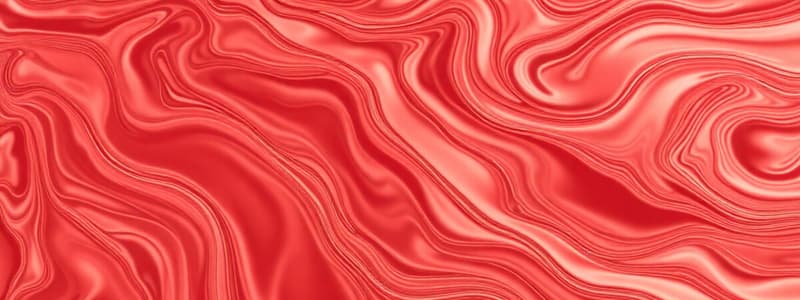Podcast
Questions and Answers
What branch of science deals with the motion of particles without considering the forces responsible for that motion?
What branch of science deals with the motion of particles without considering the forces responsible for that motion?
- Dynamics
- Kinematics (correct)
- Statistical Mechanics
- Thermodynamics
What does a stream line represent in a flow field?
What does a stream line represent in a flow field?
- The pressure distribution in the fluid
- The viscosity of the fluid
- The total flow rate of a fluid
- The velocity vector direction at a point (correct)
How is the time taken by a fluid particle to move a distance 'ds' along a stream line expressed?
How is the time taken by a fluid particle to move a distance 'ds' along a stream line expressed?
- t = Vs/ds
- t = ds/Vs (correct)
- t = dy/Vs
- t = dx/dy
What does a path line represent in fluid mechanics?
What does a path line represent in fluid mechanics?
What is the definition of a streak line in fluid mechanics?
What is the definition of a streak line in fluid mechanics?
In steady flow, how do stream lines relate to path lines and streak lines?
In steady flow, how do stream lines relate to path lines and streak lines?
What occurs in unsteady flow concerning fluid particles and stream lines?
What occurs in unsteady flow concerning fluid particles and stream lines?
In the context of instantaneous stream lines, what happens in time-dependent flow?
In the context of instantaneous stream lines, what happens in time-dependent flow?
What characterizes unsteady flow?
What characterizes unsteady flow?
What is the definition of a stream tube?
What is the definition of a stream tube?
In laminar flow, how do fluid particles move?
In laminar flow, how do fluid particles move?
Which type of flow occurs when the density of fluid is not constant?
Which type of flow occurs when the density of fluid is not constant?
How is the rate of flow (discharge) for incompressible fluids expressed?
How is the rate of flow (discharge) for incompressible fluids expressed?
What differentiates rotational flow from irrotational flow?
What differentiates rotational flow from irrotational flow?
In which type of flow does the velocity vary significantly across three dimensions?
In which type of flow does the velocity vary significantly across three dimensions?
What defines uniform flow in a fluid?
What defines uniform flow in a fluid?
How is the Reynolds number related to flow types?
How is the Reynolds number related to flow types?
Which of the following is true about steady flow?
Which of the following is true about steady flow?
What happens when a fluid particle moves along a stream line in unsteady non-uniform flow?
What happens when a fluid particle moves along a stream line in unsteady non-uniform flow?
Which statement accurately describes a streak line?
Which statement accurately describes a streak line?
What differentiates a path line from a stream line?
What differentiates a path line from a stream line?
In which scenario do stream lines, path lines, and streak lines coincide?
In which scenario do stream lines, path lines, and streak lines coincide?
What is the relationship between the components of velocity and differential distance along a stream line?
What is the relationship between the components of velocity and differential distance along a stream line?
What characterizes an instantaneous stream line in fluid motion?
What characterizes an instantaneous stream line in fluid motion?
Which aspect of kinematics is essential for determining pressure distribution in a fluid?
Which aspect of kinematics is essential for determining pressure distribution in a fluid?
What do stream lines indicate about fluid flow?
What do stream lines indicate about fluid flow?
What is a characteristic of steady flow?
What is a characteristic of steady flow?
What distinguishes laminar flow from turbulent flow?
What distinguishes laminar flow from turbulent flow?
In the context of fluid flow classifications, which type experiences a variation in velocity across space?
In the context of fluid flow classifications, which type experiences a variation in velocity across space?
What does the concept of a stream tube imply?
What does the concept of a stream tube imply?
What happens to the density of a fluid in compressible flow?
What happens to the density of a fluid in compressible flow?
In which scenario is the Reynolds number critical for determining flow type?
In which scenario is the Reynolds number critical for determining flow type?
Which flow is characterized by uniform velocity across its cross-section?
Which flow is characterized by uniform velocity across its cross-section?
What is the primary characteristic of irrotational flow?
What is the primary characteristic of irrotational flow?
What describes the behavior of fluid particles in a zigzag pattern?
What describes the behavior of fluid particles in a zigzag pattern?
What distinguishes compressible fluid flow from incompressible fluid flow?
What distinguishes compressible fluid flow from incompressible fluid flow?
Flashcards
Kinematics
Kinematics
The study of motion without considering the forces causing it.
Streamline
Streamline
An imaginary line in a flow field where the tangent shows velocity direction.
Pathline
Pathline
The actual path a single fluid particle takes.
Streakline
Streakline
Signup and view all the flashcards
Steady Flow
Steady Flow
Signup and view all the flashcards
Unsteady Flow
Unsteady Flow
Signup and view all the flashcards
Instantaneous Streamline
Instantaneous Streamline
Signup and view all the flashcards
Differential Equation of Streamline
Differential Equation of Streamline
Signup and view all the flashcards
Uniform Flow
Uniform Flow
Signup and view all the flashcards
Laminar Flow
Laminar Flow
Signup and view all the flashcards
Turbulent Flow
Turbulent Flow
Signup and view all the flashcards
Compressible Flow
Compressible Flow
Signup and view all the flashcards
Incompressible Flow
Incompressible Flow
Signup and view all the flashcards
Stream Tube
Stream Tube
Signup and view all the flashcards
Discharge (Q)
Discharge (Q)
Signup and view all the flashcards
What does kinematics study?
What does kinematics study?
Signup and view all the flashcards
What is a streamline?
What is a streamline?
Signup and view all the flashcards
What is a pathline?
What is a pathline?
Signup and view all the flashcards
What's a streakline?
What's a streakline?
Signup and view all the flashcards
What is unsteady flow?
What is unsteady flow?
Signup and view all the flashcards
What makes flow turbulent?
What makes flow turbulent?
Signup and view all the flashcards
How is flow classified?
How is flow classified?
Signup and view all the flashcards
What is rotational flow?
What is rotational flow?
Signup and view all the flashcards
What is compressible flow?
What is compressible flow?
Signup and view all the flashcards
What is a stream tube?
What is a stream tube?
Signup and view all the flashcards
What is discharge (Q)?
What is discharge (Q)?
Signup and view all the flashcards
What is uniform flow?
What is uniform flow?
Signup and view all the flashcards
What makes flow laminar?
What makes flow laminar?
Signup and view all the flashcards
What is a 3-dimensional flow?
What is a 3-dimensional flow?
Signup and view all the flashcards
Study Notes
Kinematics
- Kinematics studies the motion of particles without considering the forces causing it.
- Velocity determines pressure distribution and forces on a fluid.
Streamlines
- A streamline is an imaginary line in a flow field where the tangent represents velocity direction.
- No flow occurs across a streamline.
- The differential equation for a streamline is: dx/u = dy/v = ds/w, where u, v, w are velocity components and ds is a short distance along the streamline.
Path Lines
- A path line is the trajectory of a specific fluid particle.
- It's the curve traced by a single particle as it moves through the flow.
- Path lines can be different from streamlines in unsteady flows.
Streak Lines
- A streak line shows the path of fluid particles passing through a fixed point (marked with dye or smoke).
- It connects all particles passing through that point
- In steady flow, streamlines, path lines, and streak lines coincide.
Instantaneous Streamlines
- Instantaneous streamlines represent the location of streamlines at a particular instant in time.
- In time-dependent flows, streamlines change with time.
Stream Tubes
- Streamlines forming a closed curve create a stream tube.
- Fluid cannot cross the stream tube's boundary.
- Fluid entering and leaving a stream tube must be equal.
- Streamtubes are assumed to have a uniform velocity.
Flow Classifications
- Steady/Unsteady:
- Steady flow: fluid properties at a point don't change with time (dv/dt = 0, dp/dt = 0, dρ/dt = 0).
- Unsteady flow: fluid properties change with time (dv/dt ≠ 0, dp/dt ≠ 0, dρ/dt ≠ 0).
- Uniform/Non-uniform:
- Uniform flow: velocity at a given time doesn't change with space.
- Laminar/Turbulent:
- Laminar flow: smooth, layer-like movement along streamlines.
- Turbulent flow: zigzag movement, eddies, and high energy loss. Reynolds number (VD/v) determines type, for pipe flow.
- Compressible/Incompressible:
- Compressible flow: fluid density changes (ρ ≠ Constant).
- Incompressible flow: fluid density is constant (ρ = Constant). Liquids are generally incompressible; gases are compressible.
- Rotational/Irrotational:
- Rotational flow: fluid particles rotate.
- Irrotational flow: no particle rotation.
- One, Two, Three-Dimensional:
- One-dimensional: flow parameters are functions of time and one spatial coordinate.
- Two-dimensional: flow parameters are functions of time and two spatial coordinates.
- Three-dimensional: flow parameters are functions of time and three spatial coordinates.
Discharge (Rate of Flow)
- Discharge (Q) is the fluid quantity flowing per second.
- For liquids, units are m³/s or L/s.
- For gases, units are kgf/s or N/s.
Studying That Suits You
Use AI to generate personalized quizzes and flashcards to suit your learning preferences.





